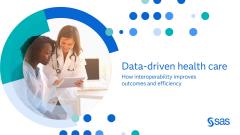It is no surprise that generative AI (GenAI) is quickly becoming a potent tool in the health and life sciences industry.
There are numerous ways that AI and GenAI can help beat the rising tide of fraud. We can count on these new technologies to enable the ability to commit fraud and fight it.
In this Q&A, Mark Lambrecht, PhD, Global Director of Health Care and Life Sciences at SAS, explains the far-reaching effects of health care fraud – it touches everyone and can raise care costs and potentially harm patients.
What is the most prevalent type of fraud in health care?
Mark Lambrecht: Most health care providers are honest and well-intentioned. Mistakes can happen –sometimes there are bad actors looking for loopholes. The most common fraudulent behavior is around billing.
For instance, billing for services not provided (phantom billing) or billing for a more expensive service than was what was actually provided or billing for unnecessary services (up billing). Another example is submitting separate bills for procedures that should be billed together at a reduced cost.
By using data, advanced analytics and new technologies, organizations can reduce incidences.
In the health care industry, who is most affected by fraud?
Lambrecht: All sectors are impacted, including drug and device manufacturers, hospitals, pharmacies, physicians, suppliers, distributors, laboratories, patients and payers. The hardest hit group might be the payers, including public as well as private ones.
What are some examples of the challenges posed by fraud?
Lambrecht: Cybersecurity is crucial in health care as they are prime targets for attacks because they handle vast amounts of data. Organizations must preserve data integrity and prevent fraud.
Identity fraud or synthetic IDs pose an issue because they can lead to severe consequences for both patients and the health care system. When someone uses your personal health information to receive medical care, prescription drugs, or insurance benefits, it not only disrupts individual lives but also undermines the integrity of the health care system.
A rapidly growing trend we are seeing is fraud with GLP-1 drugs. These are very expensive – approximately $30,000 a year per patient – making it an attractive target. Fraudsters go where the money is. Counterfeit GLP-1 drugs are often sold online and can be dangerous due to incorrect ingredients, improper storage, or unsterile needles. The high demand and cost of these medications make them an easy target for fraud.
In the US, health care fraud costs around $68 billion annually. It’s not just a costly issue, but also a global epidemic.
What would help health care better detect fraudulent behavior?
Lambrecht: There are many opportunities to catch and prevent fraud. For example, making financial and health care data more interoperable between health care systems. It plays a crucial role in enhancing fraud detection by enabling data exchange and integration across different systems and organizations.
Interoperable systems provide a holistic view and help identify patterns, anomalies and inconsistencies. Then real-time monitoring of transactions and claims becomes possible. This allows for the immediate detection of suspicious activities, such as duplicate billing or unusual provider behavior.
Advanced health analytics and machine learning make this possible because these techniques can analyze enormous amounts of data and detect fraud more accurately and efficiently. Identifying fraud before claims are paid is certainly a more effective way to prevent fraud and abuse.
How can AI and GenAI help fight health care fraud?
Lambrecht: Technologies have advanced significantly through data-driven innovations, such as data mining, analytics, machine learning and other forms of AI.
Claims processing is a good example of how AI can combat fraud. AI techniques like machine learning algorithms can review health insurance claims. The algorithms can detect duplication and identify fraud more easily, faster and more accurately. That’s a proactive approach that tackles payment integrity issues from every angle and at every stage of the claims process to stop improper payments.
Key to these schemes is implementation with a “human-in-the-loop,” as there have been cases of algorithms erroneously targeting innocent system users. No automated system is error-free, but if applied correctly, it can help with efficiency and reduce workloads.
Another new technology revolutionizing health care is synthetic data. Clinicians and researchers are realizing the benefits. Synthetic data can mimic real patient data without exposing sensitive information and address biases that can occur in real-world data.
Health care generates a vast amount of data. Synthetic data can aid with training machine learning models and improve their ability to detect patterns and anomalies. This is extremely helpful in fraud detection.
Together, synthetic data, AI and GenAI are improving accuracy, efficiency and productivity in organizations.
With AI and GenAI, what are some important considerations?
Lambrecht: Rapid adaptation has created potential vulnerabilities. Health care organizations have a significant responsibility to ensure the trustworthiness of AI and generative AI technologies. These are three key aspects:
- AI must be designed to ensure it doesn’t create biases and provide accurate and reliable information. Following regulatory guidelines is essential.
- Safeguarding patient data is paramount. Effective data management and integrity practices are vital to secure data. Data privacy and security measures must be in place to prevent unauthorized access.
- Transparency in AI is crucial to explaining care decisions. Knowing there’s accountability and logic involved builds trust and reassures everyone.
What motivates you to fight fraud?
Data and AI are transforming health care
Discover how AI solutions for health care can automate your processes to increase productivity, improve health outcomes, modernize public health, manage costs and fight fraud.
Learn more about the benefits of interoperable data-driven health care. Check out the e-book.


